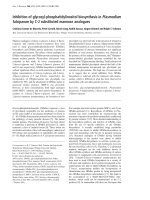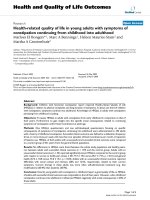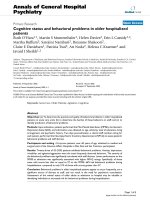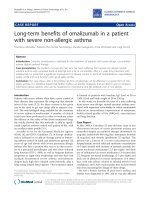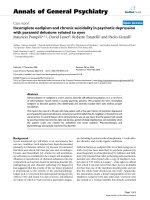Báo cáo y học: "Skeletal muscle sodium glucose co-transporters in older adults with type 2 diabetes undergoing resistance training"
Bạn đang xem bản rút gọn của tài liệu. Xem và tải ngay bản đầy đủ của tài liệu tại đây (964.72 KB, 8 trang )
Int. J. Med. Sci. 2006, 3
84
International Journal of Medical Sciences
ISSN 1449-1907 www.medsci.org 2006 3(3):84-91
©2006 Ivyspring International Publisher. All rights reserved
Research paper
Skeletal muscle sodium glucose co-transporters in older adults with type 2 diabetes
undergoing resistance training
Francisco Castaneda
1
, Jennifer E. Layne
2
, and Carmen Castaneda
2
1. Max Planck Institute for Molecular Physiology, Dortmund, Germany.
2. Nutrition, Exercise Physiology and Sarcopenia Laboratory, Jean Mayer U.S. Department of Agriculture (USDA) Human
Nutrition Research Center on Aging, Tufts University, Boston, MA, USA.
Corresponding address: Francisco Castaneda, M.D., Max Planck Institute for Molecular Physiology, Otto-Hahn-Str. 11, 44227
Dortmund, Germany. Telephone: 49 231 133-2222. Fax: 49 231 133-2699. E-mail:
Received: 2006.04.10; Accepted: 2006.05.16; Published: 2006.05.17
We examined the expression of the sodium-dependent glucose co-transporter system (hSGLT3) in skeletal muscle of
Hispanic older adults with type 2 diabetes. Subjects (65±8 yr) were randomized to resistance training (3x/wk, n=13)
or standard of care (controls, n=5) for 16 weeks. Skeletal muscle hSGLT3 and GLUT4 mRNA transcript levels were
determined by real time RT-PCR. hSGLT3 transcripts increased by a factor of ten following resistance training
compared to control subjects (0.10, P=0.03). There were no differences in GLUT4 mRNA expression levels between
groups. Protein expression levels of these transporters were confirmed by immunohistochemistry and Western
blotting. hSGLT3 after resistance exercise was found not to be co-localized with the nicotinic acetylcholine receptor.
The change in hSGLT3 transcript levels in the vastus lateralis muscle was positively correlated with glucose uptake, as
measured by the change in muscle glycogen stores (r=0.53, P=0.02); and with exercise intensity, as measured by the
change in muscle strength (r=0.73, P=0.001). Group assignment was be the only independent predictor of hSGLT3
transcript levels, explaining 68% of its variability (P=0.01). Our data show that hSGLT3, but not GLTU4, expression
was enhanced in skeletal muscle after 16 weeks of resistance training. This finding suggests that hSGLT3, an
insulin-independent glucose transporter, is activated with exercise and it may play a significant role in glycemic
control with muscle contraction. The hSGLT3 exact mechanism is not well understood and requires further
investigation. However its functional significance regarding a reduction of glucose toxicity and improvement of
insulin resistance is the subject of ongoing research.
Keywords: SGLT co-transport, diabetes, resistance training
1. Introduction
Diabetes mellitus has a high incidence worldwide.
The International Diabetes Federation estimates that at
least 177 million people in the world have diabetes.
Approximately 90-95% of people who are diagnosed
with diabetes have type 2 diabetes. It results from insulin
resistance combined with relative insulin deficiency [1].
Both insulin resistance and deficiency leads to
hyperglycemia due to altered glucose transport into the
cells. Cellular glucose uptake requires transport
proteins because it does not freely permeate the plasma
membrane [2]. Glucose transport proteins are divided in
two groups: glucose facilitated transporters (GLUT) and
sodium dependent D-glucose co-transporters (SGLT).
GLUT allows transport of glucose down its concentration
gradient, while SGLT transports glucose against its
concentration gradient.
The causes of type 2 diabetes are numerous and
complex, but physical inactivity is an important factor.
Exercise, the major physiological activator of muscle
glucose transport, regulates the expression of GLUT4 in
skeletal muscle [3, 4], and induces its translocation from
the intracellular pool to the plasma membrane [5, 6].
However, sustained insulin deficiency leads to a
decreased number of GLUT4 transporters, resulting in
impaired responsiveness of glucose transport to both
insulin and exercise [4, 7]. People with type 2 diabetes
have been shown to have defective insulin-dependent
glucose transport in skeletal muscle [8]. This is of
concerned given that skeletal muscle plays an important
role in glucose homeostasis, primarily due to its effect on
postprandial glucose uptake [9].
The sodium-dependent D-glucose co-transport
system is mainly expressed in skeletal muscle [10]. It
was first described as SAAT-pSGLT2 due to its
similarities with other components of the SGLT2 system
in the kidney of pigs [9]. It has been renamed hSGLT3
after finding it in human DNA sequence of chromosome
22, and is considered a member of the SLC5 gene family
[11]. Secondary active transport of glucose across the
muscle membrane via hSGLT3 represents an
insulin-independent form of glucose uptake [2].
Currently, there are no studies investigating the
association between the expression of hSGLT3 and
exercise. However, molecular targets of anti-diabetic
drugs are using SGLT inhibitors as a promising agent
[12].
Resistance exercise is the only non-pharmacological
modality known to increase muscle mass [13]. We have
shown that progressive resistance training improves
glycemic and metabolic control among high-risk older
adults with type 2 diabetes [14]. Research on the effects
of exercise-induced glucose disposal implicates the role
of enhanced GLUT4 transport system [15]. However,
there are no published studies examining the relationship
Int. J. Med. Sci. 2006, 3
85
between the expression of hSGLT3 and resistance
exercise training. Therefore, we undertook this pilot
investigation based on the hypothesis that older adults
with uncontrolled diabetes (poor glycemic control and
sustained hyperglycemia) engaged in resistance exercise
training for 16 weeks, would exhibit improved glycemic
control associated with enhanced expression and
synthesis of hSGLT3 in skeletal muscle. If in fact
exercise training increases SGLT-mediated glucose
transport, the novel findings of this investigation would
provide preliminary information on a possible
physiological target to be studied further for the
management of type 2 diabetes.
2. Methods
Experimental subjects and training program
Sixty-two community-dwelling Hispanic men and
women over 55 years of age with type 2 diabetes were
randomized to 16 weeks of standard care (control group)
or standard care plus progressive resistance training (RT
group) as previously described [14]. Hispanic subjects
were chosen because of their high likelihood of having
poor glycemic control. Eligible subjects gave written
informed consent approved by the Institutional Review
Board at Tufts-New England Medical Center. For the
present study, a subset of 18 subjects (RT, n=13 and
Controls, n=5) who agreed to have a muscle biopsy were
studied.
Subjects randomized to resistance training exercised
at the Jean Mayer USDA Human Nutrition Research
Center on Aging (HNRCA) at Tufts University 3 times
per week under supervision. The exercise sessions
consisted of a 5-min warm-up, 35-min exercise using 2
upper and 3 lower body pneumatic resistance training
machines, and a 5-min cool-down. Training began at
60-65% of one repetition maximum (1RM) and
progressed to 75-80% of 1RM by the end of the first 4
weeks. 1RM was reassessed at weeks 8 and 16, and the
workload adjusted accordingly. Control subjects
received phone calls every other week and came to the
HNRCA for testing during baseline, mid- and post-study
[14].
Outcome Measures
Baseline measures were taken prior to
randomization. Biochemical measurements were
collected in the fasting state. All study measures were
carried out in a blinded fashion with the exception of
muscle strength.
hSGLT3 and GLUT4 gene expression
RNA Extraction
Skeletal muscle samples were obtained in the
non-dominant vastus lateralis muscle by percutaneous
needle biopsy using a 5 mm Bergstrom needle [16] at
baseline and 72 h after final strength testing.
Approximately, 20 mg were homogenized using a
polytron homogenizer (Tissue Tearor, BioSpec Products,
Inc., Bartlesville, OK) in a mono-phase solution of phenol
and guanidine thiocyanate (TRI-Reagent, Molecular
Research Center, Cincinnati, OH). Total RNA was
extracted per manufacturer’s instructions. To ensure
removal of genomic DNA contaminants, samples were
subjected to RNase-free DNase for on-column DNase
digestion (QIAGEN Inc, Valencia, CA). DNA-free RNA
was eluted using diethylpyrocarbonate-treated water.
Total RNA concentrations were determined
spectrophotometrically.
Quantitative real-time reverse transcription-polymerase chain
reaction (RT-PCR)
The expressions of hSGLT3 and GLUT4 before and
after the intervention were determined by relative
quantitative real time PCR. Specific primers for real
time PCR were designed using the software
PrimerExpress (Applied Biosystems, Darmstadt,
Germany) and obtained from MWG-Biotech AG
(Ebersberg, Germany). The primers for hSGLT3 were:
(forward) 5’-TAG CTG AGA CCC CAG AGC CA-3’) and
(reverse) 5’-CAG CAT TTC GGA TGT GGT CA-3’. The
primers for GLUT4 were: (forward) 5’-CTC ATT GGC
GCC TAC TCA GG-3’ and (reverse 5’-CAC GTA CAT
GGG CAC CAG C-3’. Real time PCR was performed in
an ABI PRISM GeneAmp
®
5700 sequence detection
system (Applied Biosystems) using one-step QuantiTect
SYBR green RT-PCR kit (Qiagen, Hilden, Germany).
Gene expression 16 weeks after the intervention was
evaluated against baseline. For normalization the
housekeeping gene GADPH was applied as a reference
gene. The primers for GADPH were: (forward) 5’-CAA
GGT CAT CCC TGA CGT GAA-3’ and (reverse) 5’-CAG
GTC CAC CAC TGA CAG GT-3’. The analysis of relative
real time RT-PCR quantification was obtained using the
threshold cycle (C
T
) values and calculated by the
Delta-Delta Ct method and converted to relative
expression ratio (2
-ΔΔCt
) for statistical analysis [17, 18].
The efficiency of PCR amplification for hSGLT3, GLUT4
and GAPDH was confirmed in a series of validation
studies prior to quantitation. Melting temperature
curves were used to evaluate the specificity of the
amplification products.
hSGLT3 and GLUT4 protein expression
Immunohistochemistry
Ten-micron tissue cryosections of the vastus
lateralis muscle specimens obtained before and after the
16-week intervention were mounted onto Plus-Superfrost
slides (VWR International, Vienna, Austria). The slides
were rinsed with phosphate buffer solution (PBS) + 0.3%
Triton-X100 + 0.1% bovine serum albumin (BSA) at room
temperature. Subsequently, cryosections were first
blocked (30 min) with PBS containing 0.3% milk powder
and then rinsed with PBS + 0.3% Triton-X100 + 0.1% BSA
for 15 min. The slides were then incubated with
primary antibody directed against SGLT3 (QIS30, 1:100
in PBS + 1% BSA + 3% milk powder) or against GLUT4
(ab654, Acris, Hiddenhausen, Germany). QIS30
–amino acids 243-272, is a polyclonal rabbit antiserum
against SGLT synthesized in our laboratory [19]. This
sequence is an epitope homologous in rabbit SGLT1 and
in human SGLT3, as confirmed by the Genetics
Computer Group (GCG) software program version 9.0
(Accelrys, Cambridge, UK). Cy3-conjugated donkey
anti-rabbit IgG antibody (1:500, Jackson
ImmunoResearch) in PBS + 1% BSA + 3% milk powder
for 60 min at room temperature was used as a second
antibody. Cell nuclei were counterstained with a
4-,6-diamidino-2-phenylindole (DAPI) solution (1:40000
Int. J. Med. Sci. 2006, 3
86
in PBS). For co-localization studies of hSGLT3 and the
nicotinic acetylcholine receptor we used QIS30 and a
mouse monoclonal antibody (ab11151, Acris),
respectively. As a second antibody we used FITC
conjugated goat anti-rabbit IgG (1:100, Sigma) for SGLT3
and Alexa Fluor 555-conjugated anti-mouse IgG (1:100,
Invitrogen) for the nicotinic acetylcholine receptor.
Immunohistochemical analyses were performed by
fluorescence microscopy.
Western Blotting
Western blotting was performed using the single
section Western blot (SSWB) method described by
Cooper [20] and normalized to GAPDH. Detection was
performed using the ECL Western Blot Detection Kit
(PerkinElmer, Rodgau-Jügesheim, Germany). Bands
were quantified using Scion Image software for
Windows (NIH, Bethesda, USA). Briefly, muscle biopsy
cryosections (10 µm thickness, 10 mm
2
cross-sectional
area) were solubilized using SSWB-lysis buffer
containing 4% SDS, 125 mM Tris pH 8.8, 40% glycerol, 0.5
mM phenylmethylsulfonyl fluoride, 100 mM
dithiothreitol, and bromophenol blue. Samples were
sonicated, heated to 94 °C for 4 minutes, and briefly spun
(3 min, 15,000 g) before loading. Protein concentration
was measured by absorption measurement at 280 nm
using a BioPhotometer method (Eppendorf, Hamburg,
Germany). Twenty µL muscle lysate was loaded per
lane and electrophoresed on 4 to 12% gradient
SDS-PAGE gels (Invitrogen, Karlsruhe, Germany) at 30 to
35 mA constant current overnight onto 0.45 µm PVDF
membranes (Millipore Corp., Bedford, MA). Then, the
PVDF membranes were blotted with QIS30, anti GLUT4
or anti GAPDH (CSA-335, Stressgen, Victoria, Canada) at
1:2,000 in PBS + Tween 20 + 2% BSA for 1 hr at room
temperature. Bound anti-QIS30 and GLUT4 was detected
using donkey anti-rabbit-IgG conjugated to horseradish
peroxidase (1:2000 in PBS + Tween 20 + 2% BSA) for 1 hr
at room temperature, and anti-GAPDH was detected
using anti-mouse IgG (Sigma).
Muscle glycogen
Muscle glycogen stores (a surrogate of glucose
disposal) were determined by hexokinase enzymatic and
spectrophotometric analyses (Sigma Diagnostics, St.
Louis, MI) with a C.V. of 5% [21].
Muscle Strength
One repetition maximum (1RM) was assessed twice
on each machine at baseline (prior to randomization),
and once at 16 weeks. Baseline and final muscle
strength was calculated as the sum of 1RM measures for
all machines used for training.
Statistical analysis
Statistical analysis was performed using SPSS 12.0
for Windows (SPSS, Inc., Evanston, IL). Results were
statistically significant if the 2-tailed p-value was less
than 0.05. Variables were checked for normality.
Non-normally distributed variables were
log-transformed, checked for normality after log
transformation, and used as continuous log-transformed
variables for analyses. Data are shown as mean and
standard deviation (SD) or median for non-normally
distributed variables. Baseline comparisons were
assessed by independent sample t-test or Chi-square as
appropriate. To test the significance of resistance
training in predicting main (hSGLT3 and GLUT4 gene
and protein expression levels) and secondary (muscle
glycogen stores and muscle strength) study outcomes,
analysis of covariance of the absolute change (week 16 –
week 0) in each outcome variable was carried out
adjusted for age, gender and years with diabetes when
appropriate. Secondary, stepwise multiple regression
analysis was performed to determine independent
predictors of the change in hSGLT3. Independent
predictive variables were chosen based on their
statistically significant association with main outcomes at
baseline, as determined by univariate analysis using
Pearson's correlation coefficient. These variables were
the changes in lean body mass and muscle strength
(referring to training intensity) as well as the change in
muscle glycogen stores (surrogate for glucose disposal).
Group assignment was forced into the model.
3. Results
Subject Characteristics
As shown in Table 1, subjects in this study were on
average obese, older and with uncontrolled, long-term
type 2 diabetes.
Table 1. Baseline Subject Characteristics
Resistance Training
(N=13)
Control
(N=5)
P-value
*
Age (yr) 66 ± 8 60 ± 4 0.17
Sex (women/men) 9/4 3/2 0.63
Body Mass Index (kg/m
2
) 32.1 ± 6.8 33.4 ± 6.3 0.28
Year with Diabetes (y) 8 ± 6 10 ± 6 0.99
Glycosylated Hemoglobin
(%)
8.6 ± 1.8 8.1 ± 1.2 0.41
Fasting Blood Glucose
(mg/dL)
147 ± 35 147 ± 30 0.63
Data are means ± SD
Baseline comparisons between groups were assessed using independent sample
t-test comparisons for continuous and log transformed variables, while
Chi-square was used for categorical variables.
hSGLT3 and GLUT4 gene expression
As shown in Figure 1, the median relative
expression ratio (2
-ΔΔCt
) of hSGLT3 transcript levels in
skeletal muscle increased by a factor of 10.02 after 16
weeks of progressive resistance exercise training
compared to control subjects (0.10, P = 0.03). In contrast,
there were no differences in GLUT4 transcript levels
between groups. The latter corresponded to median
values of 0.86 and 0.70 after the 16-week study, for the
exercise and control groups, respectively (NS). The
expression of hSGLT3 and GLUT4 was confirmed by
melting temperature (Tm) analysis. The obtained
temperature for hSGLT3, GLUT4 and GADPH were 72°C,
80°C and 82°C, respectively.
hSGLT3 and GLUT4 protein expression
Given the elevation in hSGLT3 transcript levels we
observed with 16 weeks of resistance training, we further
determined the expression of hSGLT3 and GLUT4 at the
protein level by immunohistochemical detection (Figure
2) and Western blotting (Figure 3) only in subjects
randomized to exercise. This confirmatory step could
only be done in a small sample of exercise subjects (n=5)
for whom skeletal muscle tissue was available. Figure 2
Int. J. Med. Sci. 2006, 3
87
shows the immunohistochemical determination of
hSGLT3 in skeletal muscle before (Figure 2A) and after
16 weeks of resistance exercise training (Figure 2C).
hSGLT3 protein fluorescence detection levels increased
with exercise, as shown by the presence of a diffuse
pattern with a marked increase in the sarcolemma
compared to that observed before training, suggesting
that resistance exercise increased the expression of
SGLT3 in the cell membrane. GLUT4 protein expression
levels did not change with exercise (data not shown),
confirming the observation obtained by gene expression.
To further confirm the qualitative measures of protein
expression using immunohistochemical analysis, we
determine the quantity of protein expression by Western
blotting of the same tissue samples for the exercise
subjects. As shown in Figure 3, hSGLT3 but not
GLUT4 protein was abundant in the cell membrane of
the vastus lateralis muscle after 16 weeks of resistance
exercise training with GAPDH as the reference protein.
These corresponded to mean densitometric values of 145
and 10, for hSGLT3 and GLUT4, respectively. To
further evaluate the role of hSGLT3, we determined its
co-localization with the nicotinic acetylcholine receptor
before and after resistance exercise training using specific
antibodies (Figure 4). As expected, before exercise, the
nicotinic acetylcholine receptor (Figure 4.1.b) and the
hSGLT3 (Figure 4.1.c) immunoreactivity co-localized
near the nuclei. After 16 weeks of resistance training, the
nicotinic acetylcholine receptor (Figure 4.2.b) and
hSGLT3 (Figure 4.2.c) were not co-localized and
furthermore, hSGLT3 immunoreactivity was increased
compared to baseline.
Figure 1. Median relative expression ratios (2
-ΔΔCt
) for hSGLT3
and GLUT4 transcript levels in skeletal muscle after 16 weeks
of resistance training are shown for exercise (shaded bars) and
control (open bars) subjects. Error bars represent SD. * P =
0.03, difference between groups.
Figure 2. Representative immunohystochemical staining of
vastus lateralis muscle tissue (longitudinal section, 40X
magnified) using specific antibodies against hSGLT3 (QIS30:
yellow; A, before; and C, after 16 weeks of resistance exercise)
and without primary antibody (B, before; and D, after exercise).
Cell nuclei were counterstained with DAPI (blue). Scale bar is
10 μm.
Int. J. Med. Sci. 2006, 3
88
Figure 3. Representative Western blotting for hSGLT3,
GLUT4 and GAPDH are shown before and after 16 weeks of
resistance exercise training.
Muscle Glycogen Stores
Sixteen weeks of moderate-to-high intensity
resistance training (3x/week) resulted in improved
glucose disposal as measured by skeletal muscle
glycogen stores. In the
exercise group, muscle
glycogen increased by 44%
(from 60.2 ± 16.9 to 83.2 ± 21.8
mmol glucose/kg muscle,
before and after exercise,
respectively). In contrast,
control subjects showed a
mean reduction in muscle
glycogen equivalent to 13%
(from 66.7 ± 10.4 to 57.7 ± 21.4
mmol glucose/kg muscle, P =
0.04 vs. exercisers). Analysis
of covariance was adjusted for
age, gender and years with
diabetes. Of note it is
important to mention that
fasting plasma glucose did not
change between groups as
previously reported [14]. This
is not surprising given that the
role of skeletal muscle in
glucose homeostasis is
primarily related to
postprandial effects of glucose
uptake, namely glycogen
stores.
Muscle Strength
Mean training intensity
was 70.2 ± 1.3 % of 1RM (range:
66 to 75 %). Exercisers gained
on average 43 ± 29% of
whole-body muscle strength, as compared to a 19 ± 31%
loss in control subjects (P = 0.01). This analysis was
adjusted for age, gender and years with diabetes.
Secondary Analysis of Predictors of the Change in Main
Outcomes
Baseline univariate correlation analyses showed that
hSGLT3 transcript levels were positively related with
baseline values for lean body mass (r = 0.37), muscle
strength (r = 0.53), and skeletal muscle glycogen stores (r
= 0.51), all coefficients of correlation were significant at P
< 0.05. In addition, the change in hSGLT3 transcript
levels was directly correlated with the changes seen in
muscle glycogen stores –or glucose disposal (r = 0.53, P =
0.02; Figure 5A) and with the changes in muscle strength
(r = 0.73, P = 0.001; Figure 5B). Given the positive
associations between muscle mass and strength (a
function of exercise intensity), and muscle glycogen
(surrogate for glucose disposal), we used these as
independent variables in multivariate analysis to
determine predictors of the change in hSGLT3. This
analysis showed that group assignment was the only
significant predictor of the change in hSGLT3 transcript
levels, accounting for 68% of its variance (P = 0.01).
Figure 4. Representative immunohystochemical staining of
the vastus lateralis muscle tissue (transversal section, 40X
magnified) before (1.a,b,c) and after (2.a,b,c) exercise.
Specific antibodies against the nuclei were stained with DAPI
(Figures “a” shown in blue), the nicotinic acetylcholine
receptor gamma (Figures “b” shown in yellow), and hSGLT3
(Figures “c” shown in green).


